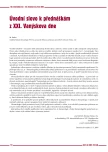Platelet membrane glycoproteins from the point of view of their genetic changes
Authors:
J. Gumulec 1; M. Penka 2; R. Richterová 1; M. Brejcha 1; D. Klodová 1; M. Wróbel 1; P. Janotová 1; K. Klaricová 1; M. Kneiflová 1; M. Kučerová 1; M. Radina 1
Authors‘ workplace:
Centrum pro trombózu a hemostázu při Onkologickém centru J. G. Mendla, Nový Jičín, přednosta prim. MUDr. Jaromír Gumulec
1; Oddělení klinické hematologie FN Brno, pracoviště Bohunice, přednosta prof. MUDr. Miroslav Penka, CSc.
2
Published in:
Vnitř Lék 2005; 91(7 a 8): 833-839
Category:
128th Internal Medicine Day - 21rd Vanysek's Day Brno 2005
Overview
The role of platelets in haemostasis is entirely essential. It starts with platelets’ adhesion to a place of vessel damage with following enlargement to the whole area of uncovered subendotelium and continues with secretion of mediators stored in platelets’ granules to form big platelets aggregations. Thrombocytes’ adhesion is a process initiated by their contact with nonphysiological surfaces. Here, collagen from the extracellular matrix and subendothelium plays a basic role. Interactions between collagen and thrombocytes are mediated by different glycoprotein receptors, implanted in platelets surface, and von Willebrand factor from plasma or subendothelium. Glycoproteins GP Ia/IIa, GP VI and very likely GP IV are the main receptors for platelets’ adhesion to collagen in conditions of low pattern stress, but during high pattern stress complex GP Ib/IX/V assumes the main role. Conformation changes in thrombocytes formed after vWF-GP Ib/IX link lead to activation of complexes GP IIb/IIa which can bind fibrinogen. Fibrinogen molecules form bridges between thrombocytes being a base for platelets aggregation.
Keywords:
platelets – haemostasis – glycoprotein receptors – von Willebrand factor – complexes GP IIb/IIIa
Sources
1. Colman RW, Marder VJ, Salzman EW et al. Plasma coagulation factor. In: Colman RW, Hirsh J, Marder VJ et al (eds). Hemostasis and thrombosis, basic principles and clinical practice. 3rd ed. Philadelphia: Lippincott 1994 : 1275–1296.
2. Kolde HJ. Haemostasis. Physiology, Pathology, Diagnostics. 1st ed. Basel: Pentapharm 2001.
3. Puchmayer V, Roztočil K. Praktická angiologie. 2. vyd. Praha: Triton 2003.
4. Spaet TH, Zucker MB. Mechanism of platelet plug formation and role of adenosin diphosphate. Am J Physiol 1964; 207 : 1267.
5. Huang TF, Holt JC, Lukasiewicz H et al. Trigramin, a low molecular weight peptide inhibiting fibrinogen interaction with platelet receptors expressed on glycoprotein IIb–IIIa complex. J Biol Chem 1987; 262 : 16157.
6. Kinlough-Rathbone R, Reimers H, Mustard J. Sodium arachidonate can induce platelet shape change and aggregation which are independent of the release reaction. Science 1976; 192 : 1011.
7. Colman RW, Figures WR, Scearce LM et al. Inhibition of collagen-induced platelet activation by 5’-p-fluorosulfonylbenzoyl adenosine: Evidence for an ADP requirement and synergistic influence of prostaglandin endoperoxides. Blood 1986; 68 : 563.
8. Gaarder A, Jonsen J, Laland S et al. Adenosine diphosphate in red cells as a factor in the adhesiveness of human blood platelets. Nature 1961; 192 : 531.
9. Shattil SJ, Brass LF. Induction of the fibrinogen receptor on human platelets by intracellular mediators. J Biol Chem 1987; 262 : 992.
10. Niewiarowski S, Kornecki E, Budzynski AZ et al. Fibrinogen interaction with platelet receptors. Ann NY Acad Sci 1983; 408 : 536.
11. Pytela R, Pierschbacher MD, Ginsberg EF et al. Platelet membrane glycoproteine IIb/IIIa: Member of a family of arg-gly-asp-specific adhesion receptors. Science 1986; 231 : 1559.
12. Kloczewiak M, Timmons S, Lukas TJ et al. Platelet receptor recognition site on human fibrinogen. Synthesis and structure-function relationship of peptides corresponding to the carboxy-terminal segment of the gamma chain. Biochemistry 1984; 23 : 1767.
13. Doolitle RF, Watt KWK, Cottrell BA et al. The amino acid sequence of the α chain of human fibrinogen. Nature 1979; 280 : 464.
14. Farrel DH, Thiagarajan P, Huang S et al. Role of fibrinogen α and γ chain sites in platelet aggregation. Proc Natl Acad Sci USA 1992; 89 : 10729.
15. Andrieux A, Hudry-Clergeon G, Ryckewaert JJ et al. Amino acid sequences in fibrinogen mediating its
interaction with its platelet receptor, GPIIb–IIIa. J Biol Chem 1989; 28 : 2909.
16. Parise LV, Steiner B, Nannizzi L et al. Fibrinogen binding sites exist on glycoprotein IIb and IIIa. Blood 1987; 70(Suppl 1): 357a.
17. D’Souza SE, Ginsberg MH, Burke TA et al. The ligand binding site of the paltelet integrin receptor GPIIb–IIIa is proximal to the second calcium binding domain of it’s α subunit. J Biol Chem 1990; 256 : 3440.
18. Zimmerman FH, Cameron A, Fisher LD et al. Myocardial infarction in young adults: Angiographic characterization, risk factors and prognosis (Coronary Artery Surgery Registry). J Am Coll Cardiol 1995; 26 : 654.
19. Kanitz MG, Giovannucci SI, Jones JS et al. Myocardial infarction in young adults: Rick factors and clinical features. J Emerg Med 1996; 14 : 139.
Labels
Diabetology Endocrinology Internal medicineArticle was published in
Internal Medicine

2005 Issue 7 a 8
Most read in this issue
- Post transfusion reactions
- Thrombocytosis and thrombocythemia
- Antiphospholipid syndrome – diagnosis and treatment
- Antiaggregant therapy
